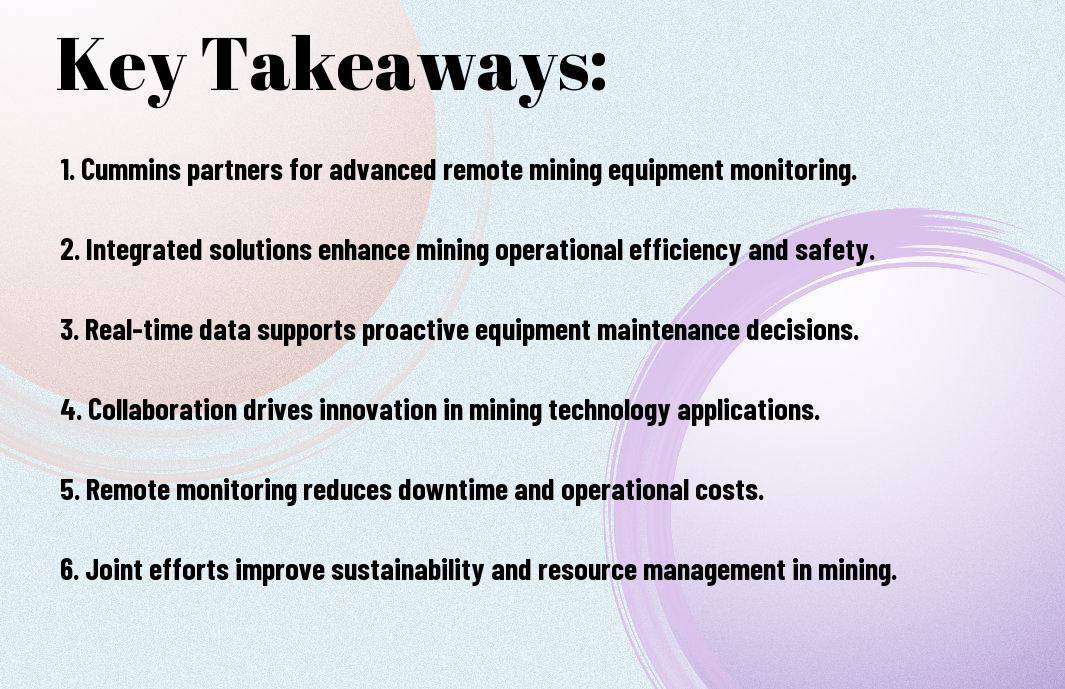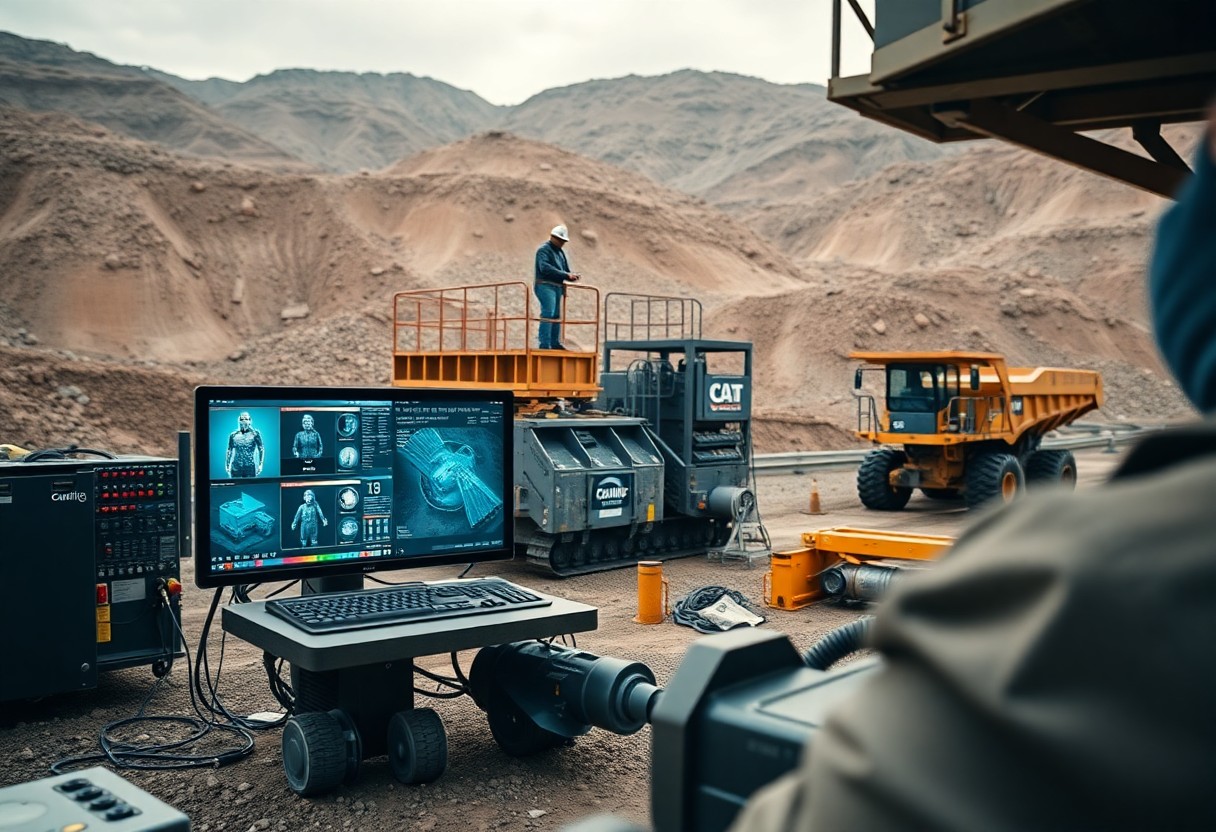Many advancements in technology are shaping the future of mining operations, particularly through remote equipment monitoring and integrated solutions provided by Cummins. In this article, I will explore how these innovations enhance operational efficiency, minimize equipment downtime, and ultimately increase safety in the field. As you navigate this evolving landscape, understanding the benefits and applicability of these joint efforts can significantly impact your mining operations. Join me as I examine into the vital role of Cummins in transforming the industry.
Key Takeaways:
- Collaboration between Cummins and mining companies enhances the efficiency of remote equipment monitoring, allowing for real-time data analysis and proactive maintenance.
- Integrated solutions provided by Cummins streamline operations, leading to improved productivity and reduced downtime in mining environments.
- The focus on remote monitoring technology supports sustainability efforts by optimizing fuel consumption and minimizing environmental impact in mining operations.

Overview of Remote Equipment Monitoring
The concept of remote equipment monitoring has transformed how mining operations manage their assets and ensure operational efficiency. I recognize this technology allows for continuous surveillance of equipment performance, significantly reducing the need for on-site checks. By leveraging real-time data analytics, I have seen how mining companies can anticipate maintenance needs, enhance safety protocols, and optimize resource allocation, leading to greater productivity.
Importance in Mining Operations
Across the mining sector, the adoption of remote equipment monitoring solutions cannot be overstated. It serves as a key tool for minimizing downtime and avoiding unexpected failures, which can be both costly and dangerous. With real-time insights, I understand that mining managers can make informed decisions that directly impact both the safety of your workforce and the operational efficiency of your site.
Technologies Used
Beside the benefits mentioned, various advanced technologies are employed in remote equipment monitoring. For instance, IoT (Internet of Things) devices collect vital operational data, while cloud computing allows for robust data storage and processing. Also, machine learning algorithms analyze this data to identify patterns and predict potential equipment issues before they escalate, providing a proactive approach to maintenance.
Also, advanced telemetry systems facilitate the seamless transfer of data from remote sites to central command centers. I find that such technology enables real-time monitoring of key performance indicators (KPIs), ensuring you can immediately address any arising challenges. The incorporation of artificial intelligence further enhances decision-making capabilities by recognizing anomalies and providing actionable insights, underscoring the positive impact these technologies have on safety and operational costs in mining. Engaging with such sophisticated monitoring solutions not only elevates your operational standards but also supports a safe working environment, leveraging innovation for success.
Integrated Solutions for Mining Efficiency
It is becoming increasingly clear that integrating various systems and technologies can lead to substantial improvements in mining operations. This integration not only fosters better communication between equipment but also enables a holistic view of the mining lifecycle. By effectively linking data from machinery, you can significantly enhance your operational decision-making capabilities, streamline workflows, and reduce downtime. With integrated solutions, the complexities of managing different systems can be mitigated, allowing you to focus on maximizing productivity and efficiency.
Benefits of Integration
Integration allows for the synchronization of workflows and the sharing of valuable data across different platforms. You can gain access to critical analytics that provide insights into equipment performance, enabling predictive maintenance protocols that minimize unexpected breakdowns. By maintaining full oversight of your operation through integrated systems, you are empowered to make data-driven adjustments that could lead to cost savings and optimized resource allocation.
Case Studies in Mining
Mining operations around the world have begun to witness significant improvements due to the implementation of integrated technologies and monitoring solutions. I have curated several insightful case studies that showcase real-world applications and their impact on mining efficiency.
- In Australia, a gold mining operation reduced equipment downtime by 30% after integrating remote equipment monitoring with predictive analytics.
- A copper mine in Chile improved its overall operational efficiency by 25% by implementing a centralized monitoring system for their fleet of heavy machinery.
- A coal mining company in the Midwest reported saving $2 million annually due to streamlined maintenance schedules facilitated by real-time data analysis.
- A silver mine in Canada achieved a 15% increase in production output within six months of adopting integrated workflow management software.
Mining companies are increasingly relying on integrated solutions to transform their operations. In fact, the effectiveness of these systems cannot be overstated; they not only boost productivity but also play a pivotal role in maintaining safety standards. Enhanced real-time monitoring capabilities allow you to identify hazardous conditions immediately, minimizing risks to personnel and equipment. Accurate data collection through integrated technologies can lead to informed decision-making that directly impacts your bottom line, making it a wise investment for any mining operation.

Cummins’ Role in Remote Monitoring
Your understanding of the mining industry will greatly benefit from knowing how Cummins integrates remote monitoring into its operations. With a commitment to operational excellence and efficiency, Cummins plays a significant role in providing advanced solutions tailored for the unique challenges faced by mining companies. The ability to monitor equipment performance in real-time allows for proactive maintenance, minimizing downtime, and optimizing productivity. I believe that your mining operations can thrive by leveraging Cummins’ expertise in this area.
Innovative Technologies
Against the backdrop of an ever-evolving technological landscape, Cummins has embraced innovative solutions that revolutionize how mining operations are monitored and managed. Their advanced remote monitoring systems utilize cutting-edge sensors and data analytics to provide real-time insights into equipment health and performance. This technology empowers you to make informed decisions that enhance both efficiency and safety, ensuring your operations run smoothly even in the most challenging environments.
Partnerships and Collaborations
Beside its technological advancements, Cummins recognizes the importance of strategic partnerships in enhancing its remote monitoring capabilities. By collaborating with OEMs, software developers, and mining companies, I find that Cummins can offer integrated solutions that go beyond simple monitoring. This collaborative approach enables the development of comprehensive systems that fuse monitoring with predictive maintenance, ultimately leading to increased productivity and cost savings for your operations.
Even more impressive is how Cummins’ partnerships often lead to innovative solutions that address specific challenges in mining. By combining the expertise of multiple stakeholders, they are able to create tailored systems designed to meet the real-world demands of your operations. This synergy not only accelerates the development of advanced technologies but also fosters an environment where continuous improvement is achievable. By engaging with Cummins and their network, you position your mining operations for enhanced operational effectiveness and sustainability.
Challenges and Solutions in Implementation
To effectively implement remote equipment monitoring and integrated solutions in mining operations, it is important to acknowledge the diverse challenges that may arise throughout the process. One of the main obstacles is the integration of legacy systems with modern technologies. Many mining sites still rely on outdated infrastructure that can hinder the seamless flow of data, ultimately reducing the effectiveness of remote monitoring solutions. Moreover, varying data standards and inconsistent connectivity in remote locations can lead to difficulties in achieving a reliable data exchange that is necessary for making informed decisions.
Common Obstacles
At the heart of these challenges lies an inherent resistance to change amongst personnel who are accustomed to traditional operational methods. This resistance can slow down the adoption of new technologies and practices, causing friction between teams and leading to delayed project timelines. Additionally, the need for ongoing training and upskilling of employees to operate sophisticated monitoring systems can strain resources, especially in smaller operations where staff may already be stretched thin.
Strategic Approaches
Between these challenges, developing a strategic approach can yield effective solutions that promote the adoption of remote monitoring technologies. Collaboration between key stakeholders—including technology providers, mining companies, and workforce representatives—is imperative for creating a unified vision. By fostering an open dialogue about the benefits and importance of these systems, you can mitigate resistance and build a shared commitment to innovation.
To ensure a successful implementation, I suggest that you establish a robust change management framework that emphasizes training and support at all levels. Incorporating pilot programs can also provide a practical way to demonstrate the benefits of remote monitoring systems, enabling your teams to experience results firsthand. This step helps to build credibility and confidence in the technology, eventually leading to broader acceptance across your operations.
Future Trends in Mining Operations
Despite the longstanding methods rooted in the mining industry, we are now witnessing a paradigm shift. As industries evolve, mining operations are increasingly adopting advanced technologies that transform how resources are extracted and managed. These innovations are paving the way for more sustainable practices, enhanced safety measures, and streamlined operations. The integration of remote equipment monitoring systems will not only boost efficiency but also allow operations to adapt to real-time data, ultimately reducing downtime and costs.
Advancements in Technology
Between the rapid development of artificial intelligence and the Internet of Things, mining operations are experiencing an unprecedented transformation. Smart sensors and automated systems are now commonplace, allowing for enhanced monitoring of machinery and extraction processes. These technologies help you pinpoint inefficiencies and implement solutions much faster than ever before. As you embrace these advancements, the potential for optimizing your operational processes increases, leading to a more productive and safer work environment.
Predictive Maintenance and Analytics
Operations in the mining sector are often hampered by the unpredictability of equipment failure, which can severely impact production timelines. By focusing on predictive maintenance and leveraging data analytics, you can shift away from reactionary practices to a more proactive approach. This transformation enables you to predict potential breakdowns and execute maintenance based on data insights, rather than relying solely on routine checks.
Consequently, predictive maintenance and analytics not only bolster the safety of your operations but also provide significant cost savings. With real-time data, you can identify patterns that indicate equipment wear and tear, allowing you to schedule maintenance before failures occur. This not only minimizes unexpected downtimes but also extends the lifespan of your machinery, thereby enhancing overall operational efficiency. As you harness the power of these advancements in analytics, you will find your approach to mining operations becoming increasingly robust and effective.
Sustainability and Environmental Considerations
Now, as we investigate deeper into the sustainability aspect of mining operations, it’s necessary to understand how integrated monitoring solutions can significantly enhance environmental responsibility. The adoption of advanced technology in the form of remote equipment monitoring allows for real-time tracking of equipment performance, fuel consumption, and emissions levels. This proactive approach not only highlights inefficiencies but also enables you to implement timely corrective measures, leading to a reduction in the overall environmental impact of your mining activities.
Reducing Environmental Impact
Along with providing insights into operational effectiveness, these solutions help in identifying specific areas of concern where emissions can be minimized and fuel usage optimized. By integrating data analytics, you gain the ability to make informed decisions that align with sustainable practices. This ultimately ensures that your operations adhere to environmental regulations while fostering a culture of environmental stewardship among your workforce.
Enhancing Resource Management
For any mining operation, effective resource management is paramount. Utilizing remote monitoring technologies not only streamlines operations but also enhances the capacity to manage resources more effectively. By having a comprehensive overview of the assets in your operation, you can ensure that every component is used to its fullest potential, thereby reducing waste and promoting sustainability.
With these integrated solutions, you can accurately assess resource availability and demands, thereby implementing strategies that maximize efficiency and minimize the extraction footprint. The ability to monitor critical metrics in real-time allows for proactive decision-making, eliminating excess use of resources and lowering operational costs. As a result, you not only contribute to a healthier environment but also improve your bottom line, making your mining operations more sustainable and profitable over the long term.
To wrap up
Considering all points, the collaboration between Cummins and mining operations presents a significant advancement in remote equipment monitoring and integrated solutions. Through these joint efforts, I see an opportunity for you to enhance operational efficiency, reduce downtime, and effectively manage maintenance schedules. By utilizing Cummins’ innovative technologies, your mining operations can benefit from real-time data insights that ensure optimal performance and longevity of equipment.
Furthermore, I encourage you to explore further the benefits of remote monitoring in your operations. For example, Planned Equipment Maintenance Made Easy with Remote offers valuable insights into how these tools can simplify your maintenance processes. I believe that embracing these integrated solutions will not only streamline your operations but also elevate your overall productivity in the mining sector.
FAQ
Q: What benefits do Cummins’ remote equipment monitoring solutions provide for mining operations?
A: Cummins’ remote equipment monitoring solutions offer several advantages for mining operations. These include real-time data collection that allows operators to monitor the performance and health of equipment from anywhere, leading to improved decision-making. The system can predict maintenance needs, thereby reducing unexpected downtime and optimizing maintenance schedules. Additionally, remote monitoring facilitates better asset utilization, leading to enhanced operational efficiency and cost savings.
Q: How do Cummins and its partners ensure data security in remote monitoring systems?
A: Cummins and its partners prioritize data security in their remote monitoring systems through multiple layers of protection. This includes encryption of data transmission, secure access protocols, and regular software updates to patch vulnerabilities. Comprehensive cybersecurity measures are implemented to safeguard sensitive operational data from unauthorized access or breaches. Furthermore, Cummins collaborates with leading cybersecurity experts to continuously enhance their systems in response to emerging threats.
Q: Can Cummins’ integrated solutions be customized for specific mining operations?
A: Yes, Cummins’ integrated solutions are designed to be flexible and adaptable to meet the unique needs of different mining operations. Their team collaborates closely with clients to assess specific requirements and tailor solutions accordingly. This may involve customizing monitoring systems, integrating existing infrastructure, and providing scalable options that can grow with the mining operation. The goal is to enhance productivity and sustainability while addressing the distinct challenges each operation faces.









